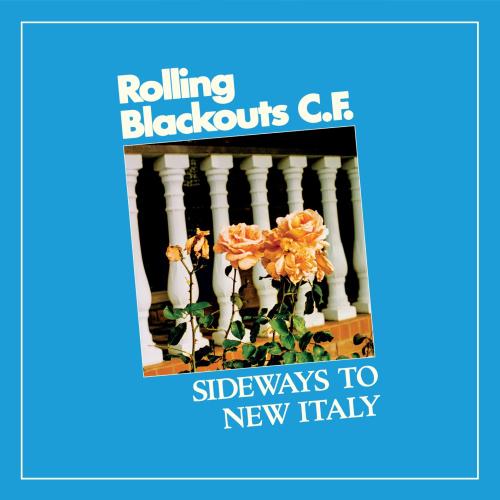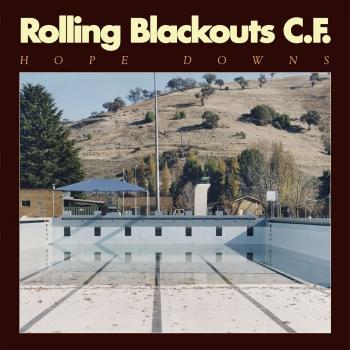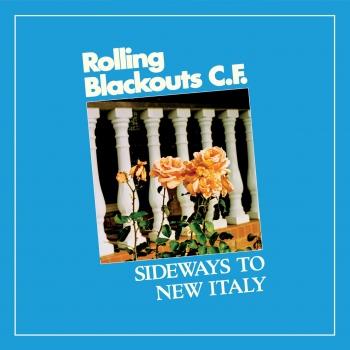
Sideways to New Italy Rolling Blackouts Coastal Fever
Album info
Album-Release:
2020
HRA-Release:
05.06.2020
Label: Sub Pop Records
Genre: Rock
Subgenre: Adult Alternative
Artist: Rolling Blackouts Coastal Fever
Album including Album cover
I`m sorry!
Dear HIGHRESAUDIO Visitor,
due to territorial constraints and also different releases dates in each country you currently can`t purchase this album. We are updating our release dates twice a week. So, please feel free to check from time-to-time, if the album is available for your country.
We suggest, that you bookmark the album and use our Short List function.
Thank you for your understanding and patience.
Yours sincerely, HIGHRESAUDIO
- 1 The Second Of The First 03:40
- 2 Falling Thunder 04:05
- 3 She's There 03:44
- 4 Beautiful Steven 03:48
- 5 The Only One 03:46
- 6 Cars in Space 04:58
- 7 Cameo 04:07
- 8 Not Tonight 04:00
- 9 Sunglasses At The Wedding 03:32
- 10 The Cool Change 04:03
Info for Sideways to New Italy
On their second record, Sideways to New Italy, Rolling Blackouts Coastal Fever have turned their gaze inward, to their individual pasts and the places that inform them. From a town in regional Australia that serves as a living relic to how immigrants brought a sense of home to an alien place, to the familiar Mediterranean statues that dot the front lawns of the Melbourne suburbs where the band members live, the inspiration for the record came from the attempts people make at crafting utopia in their backyard (while knowing there is no such thing as a clean slate). In searching for something to hold onto in the turbulence, the guitar-pop five-piece has channelled their own sense of dislocation into an album that serves as a totem of home to take with them to stages all over the world.
After enough time away from home, even the familiar starts to feel foreign. For guitar-pop five-piece Rolling Blackouts Coastal Fever, returning to Melbourne after long stretches looking out at the world through the windows of airplanes and tour vans lead to dislocation, like being the knot in the middle of a game of tug-o-war. Their second record, Sideways to New Italy (Sub Pop), sees the band interrogate their individual pasts and the places that inform them. In clicking the scattered pieces back into place, they have crafted for themselves a new totem of home to carry with them no matter where they end up.
“I felt completely rudderless on tour,” Keaney says. “It’s fun but you get to a point where you’re like, Who am I anymore? You feel like you’re everywhere and nowhere at the same time. And no one in particular.” Russo adds, “We saw a lot of the world, which was such a privilege, but it was kind of like looking through the window at other people’s lives, and then also reflecting on our own.”
Rather than dwell in the displacement, Keaney was determined to channel how he was feeling into something optimistic. “I wanted to write songs that I could use as some sort of bedrock of hopefulness to stand on, something to be proud of. A lot of the songs on the new record are reaching forward and trying to imagine an idyll of home and love.”
The eponymous New Italy is a village near New South Wales’s Northern Rivers – the area Tussie is from. A blink-and-you’ll-miss-it pit-stop of a place with fewer than 200 residents, it was founded by Venetian immigrants in the late-1800s and now serves as something of a living monument to Italians’ contribution to Australia, with replica Roman statues dotted like souvenirs on the otherwise rural landscape. The parallel between these remnants of home and the band’s own attempts to maintain connections and create familiarity during their disorienting time on the road were not lost on Russo. “These are the expressions of people trying to find home somewhere alien; trying to create a utopia in a turbulent and imperfect world.”
Home, for Russo, manifests in different ways: there’s Melbourne, where he and brother Joe grew up, but also Southern Italy where the forebears of their family originated. As members of the band individually visited the Mediterranean and returned home to Melbourne’s inner-north, where waves of European migrants forged a sense of home since the 1950s, they realized the emotional distance between the two was minuscule. The prominent and romantic Greco-Roman statues that sit outside tidy brick homes in Brunswick represent, for Russo, an attempt to “build a utopia of where your heart’s from.”
The same can be said of this record, where White’s early attempts at writing big, high-concept songs were abandoned in favor of love songs (“She’s There,” “The Only One”), and familiar voices and characters filter in and out, grounding the band’s stories in their personal histories. On “Second of the First” the voice of a close friend joins White’s partner in delivering a spoken word passage; the chorus from “Cool Change” began its life in a song the trio played in an early band, over a decade ago; the chords from “Cameo” were once in an eventually abandoned song called “Hope Downs”; an early version of “Falling Thunder” featured a reference that only their friends would recognize.
“We tried to make these little nods to our friends and loved ones, to stay loyal to our old selves,” Russo explains. “I think we were trying to recapture some of the innocent weirdness of our very first recordings,” Keaney adds of the “Cool Change” chorus. “Which I think we did.” There’s something comforting, too, in knowing the next time they’re buffeted from stage to stage around the world, they’ll be taking the voices of their loved ones with them, building a new totem of home no matter where they end up.
Rolling Blackouts Coastal Fever
Rolling Blackouts Coastal Fever
It’s rare that a band’s debut album sounds as confident and self-assured as Rolling Blackouts Coastal Fever’s Hope Downs. To say that the first full-length from the Melbourne quintet improves on their buzz-building EPs from the last few years would be an understatement: the promise those early releases hinted at has become fully realized here, with ten songs of urgent and passionate guitar pop that elicit warm memories of bands past, from the Go-Betweens’ jangle to the charmingly lo-fi trappings of New Zealand’s Flying Nun label. But don’t mistake Rolling Blackouts Coastal Fever for nostalgists: Hope Downs is the sound of a band finding its own collective voice.
The hard-hitting debut is a testament to Rolling Blackouts C.F.’s tight-knit and hard-working bonafides: prior to forming the band in 2013, singers/guitarists Fran Keaney, Tom Russo, and Joe White had played together in various garage bands, dating back to high school. “Over the years, we built up our own sound and style, guitar pop songs with bits of punk and country” says Keaney. “Then when we started this band, with Joe Russo [Tom’s brother] on bass, Marcel [Tussie, Joe White’s then-housemate] on drums, we had this immediate chemistry. We started to let the songs go where they wanted to go”.
The band’s first gigs included friends’ bars and old shopfronts. After a split EP with You Yangs (another Russo brother’s band), released in the form of a frisbee, they self-released the Talk Tight EP in 2015, with Sydney-based record label Ivy League giving it a wider release the following year. Talk Tight garnered plaudits from critics, including legendary rock scribe Robert Christgau. In 2017, Sub Pop would join the effort, helping to release The French Press EP, bringing the band’s chugging and tuneful non-linear indie rock to the rest of the world as they settled into their sound with remarkable ease.
Hope Downs was largely written over the past year in the band’s Melbourne rehearsal room where their previous releases were also written and recorded. The band’s core trio of songwriters— Fran Keaney, Joe White, and Tom Russo—hunkered down and wrote as the chaos of the world outside unavoidably seeped into the songwriting process. “We were feeling like we were in a moment where the sands were shifting and the world was getting a lot weirder. There was a general sense that things were coming apart at the seams and people around us were too”. Russo explains. “The songs on this album are like a collection of postcards about wider things that were going on through the lens of these small characters.”
The album title, taken from the name of a vast open cut mine in the middle of Australia, refers to the feeling of “standing at the edge of the void of the big unknown, and finding something to hold on to.”
With recording sessions largely taking place in the Australian winter of 2017, the band escaped the Melbourne frost and headed to drummer Marcel Tussie’s hometown in Northern New South Wales. “We were right at the foot of this beautiful mountain next to a creek,” says White. “We could play out into the bush through the night”.
“We didn’t really want to record in a studio,” says Keaney. “We thought we’d get away up North, somewhere where it was warm, and record the songs live in the same room. We wanted to make sure it sounded like us,” White explains. With the help of engineer/producer Liam Judson and his portable setup, the band recorded and co-produced these ten guitar pop gems over the course of two weeks.
Hope Downs possesses a robust full-band sound that’s all the more impressive considering the band’s studio avoidance tendencies. If you loved Talk Tight and The French Press, you certainly won’t be disappointed here—but you might also be surprised at how the band’s sound has grown. There’s a richness and weight to these songs that was previously only hinted at, from the skyscraping chorus of ‘Sister’s Jeans’ to the thrilling climax of album closer ‘The Hammer’.
The first single ‘Mainland’ follows Tom Russo’s pilgrimage to the island of his grandparent’s birth, reflecting on his own love and privilege while a refugee crisis unfolds not far away, while second cut ‘Talking Straight’ wonders “where the silence comes from, where the space originates”, and suggests loneliness be faced together.
And then there’s the sprawling overture ‘An Air Conditioned Man’, which portrays the slow burning panic of a salaryman and features some beautifully tricky guitar work weaving in and out of frame as well as a surprisingly effective spoken-word section from Tom Russo during its closing moments. “As the world around him gets faker and faker, he realises he’s getting further away from the idealism of his youth.”
Indeed, Hope Downs is as much about the people that populate the world around us—their stories, perspectives, and hopes in the face of disillusionment—as it is about the state of things at large. It’s a record that focuses on finding the bright spots at a time when cynicism all too often feels like the natural state. Rolling Blackouts C.F. are here to remind us to keep our feet on the ground—and Hope Downs is as delicious a taste of terra firma as you’re going to get from a rock band right now.
This album contains no booklet.










